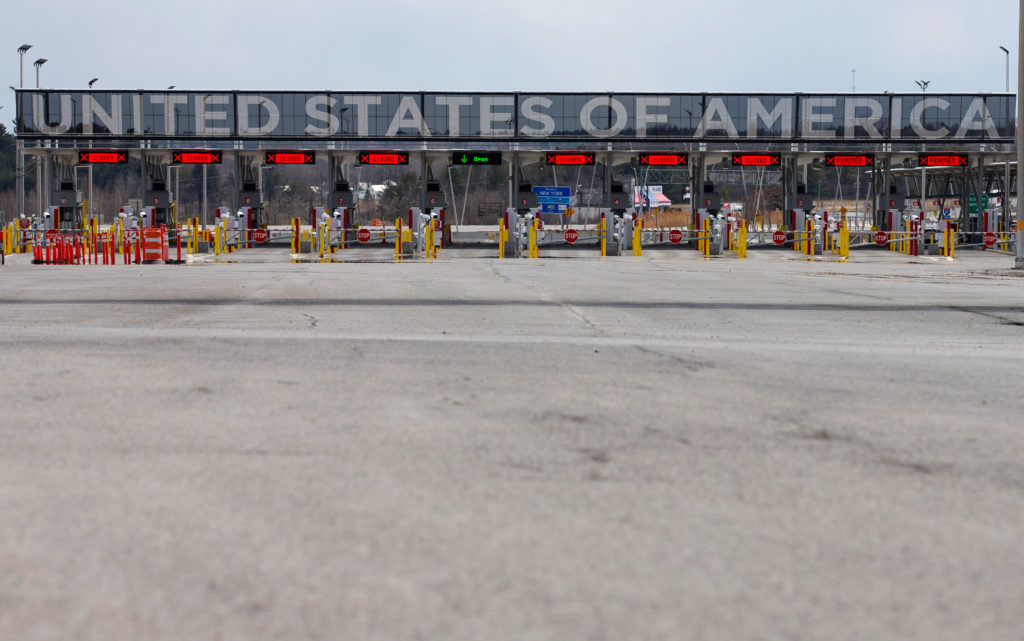
When contributing writer Robert Waite told me he was heading from his Canadian home for a family camping vacation in New England, I asked him to consider doing a piece on his experience.
Normally (pre-COVID) crossing the U.S.-Canadian border by automobile has been a relatively simple procedure, albeit one that often required long waits at immigration due to the huge volumes of traffic.
But, as Bob reports, things have changed dramatically.
By Robert Waite
Champlain, NY – Unless you have dual citizenship, perform an essential service, or hold a current student visa, don’t expect to cross the world’s longest border any time soon.
Canada currently bars all non-essential travel to the United States until September 21 – and there is every expectation the ban will be extended at least another month. The U.S. will likely reciprocate, as they have done since March.
As one who holds both American and Canadian passports, I traveled by auto to and from the U.S. in late August.
It was an eerie experience.
Twilight Zone
I was en route to New Hampshire and crossed from Stanstead, Quebec, to Derby Line, Vermont, to pick up I-91. The U.S. Customs and Immigration checkpoint — normally choked with traffic — was devoid of vehicles.
The same was true when I used a different route for my return.
In a typical July and August, the I–87 border crossing from New York into Quebec, which I elected to use, is another traffic nightmare. More than half a million people pass through during those vacation-heavy months. It is one of the busiest border crossings in the world.
But now here it was, as empty as a ghost town in a Twilight Zone episode.
In 2019 about 14 million Americans crossed into Canada. Some made day trips on business, but many came as tourists to camp, fish, or visit places like Niagara Falls, Banff, or Quebec City.
Since March of this year, none of these activities are considered valid reasons to enter the country. Indeed, since that date, according to Canadian Border Services, 16,070 U.S. citizens have been refused entry on those grounds.
This is having a devastating impact on Canada’s tourist and hospitality sector. But the tough measures have the overwhelming support of the Canadian public.
In the most recent Ipsos-Reid poll, 85% of Canadians say they want the border with the U.S. to remain closed until at least the end of 2020.
A Matter of Trust
There is a wide-spread perception among Canadians that the United States has handled the COVID-19 pandemic poorly, with its fragmented approach and uneven compliance.
It comes down to trust — and my own experience bears this out to some degree.
When I crossed into the U.S. at the Vermont border point I was asked my destination – but not for a phone number. Nor was I asked for the address of my destination.
As it happened, I was headed to Cheshire County, which at the time had the fourth lowest percentage of COVID cases per capita of any county in the U.S. But they didn’t know that.
While in New Hampshire, I was camping at a YMCA facility with a small number of family members, largely eating and sleeping out-of-doors. It was, by any measure, a relatively safe environment.
Still, it was curious that U.S. authorities had so little interest. Perhaps it was because I was headed to “Live Free or Die” New Hampshire, with all that slogan implies.
My experience re-entering Canada was quite different.
Canadian border officers asked for my address and my phone number. I was told I needed to self-quarantine for 14 days.
On my third day back I received a call from a polite young lady checking to see that I was, indeed, obeying the quarantine order. After the first week I received a recorded message telling me that the second week of quarantine is as important as the first.
Cultural Differences
I attribute a lot of the difference between the Canadian and American approach as cultural.
America stresses personal freedom. Its founding precept is “Life, Liberty and the Pursuit of Happiness.”
Canada’s, on the other hand, is “Peace, Order and Good Government.” Maybe it’s the cold winters, or some kind of lingering British-inspired deference to authority, but Canadians seem more inclined to embrace collective responses.
The Canadian approach isn’t perfect. In the early months little effort was made to contact those returning to Canada from overseas – something I heard first-hand from friends and family members.
And as recently as August our daughter flew from Los Angeles to Ottawa, via Toronto. The Canadian Border folks took her information – but never followed up with a phone call. (If they are reading this, be assured that she self-quarantined for the requisite 14 days.)
And air travel does offer something of an odd loophole.
My spouse, who holds only a Canadian passport, could not travel by car with me to New Hampshire, but she could have flown to Boston. Still, she would in theory have had to quarantine for two weeks in Massachusetts (one of the few U.S. states with such mandates), making that option impractical.
The bottom line?
Until the U.S. does a better job of demonstrating more consistent and uniform COVID compliance, travel for tourism between the two countries will remain off limits.
Donald Trump boasted of building a physical wall between Mexico and the U.S. He instead ended up creating a virtual one between the U.S. and Canada.
Author Bio: Contributing writer Robert Waite has written on travel for nearly 50 years; his previous posts for clarknorton.com include such far-flung destinations as Namibia, Rwanda, Albania, Cambodia (Angkor Wat), Laos, and Guatemala. He is also a professor at Seneca College in Toronto and Managing Partner at Waite + Co., a communications consulting firm with offices in Boston, Ottawa and Toronto.
Americans who plan to visit Canada when restrictions are lifted can read Robert Waite’s recent post on Ottawa here.













2 Responses to Canadians vs. U.S.: the COVID Border Blues